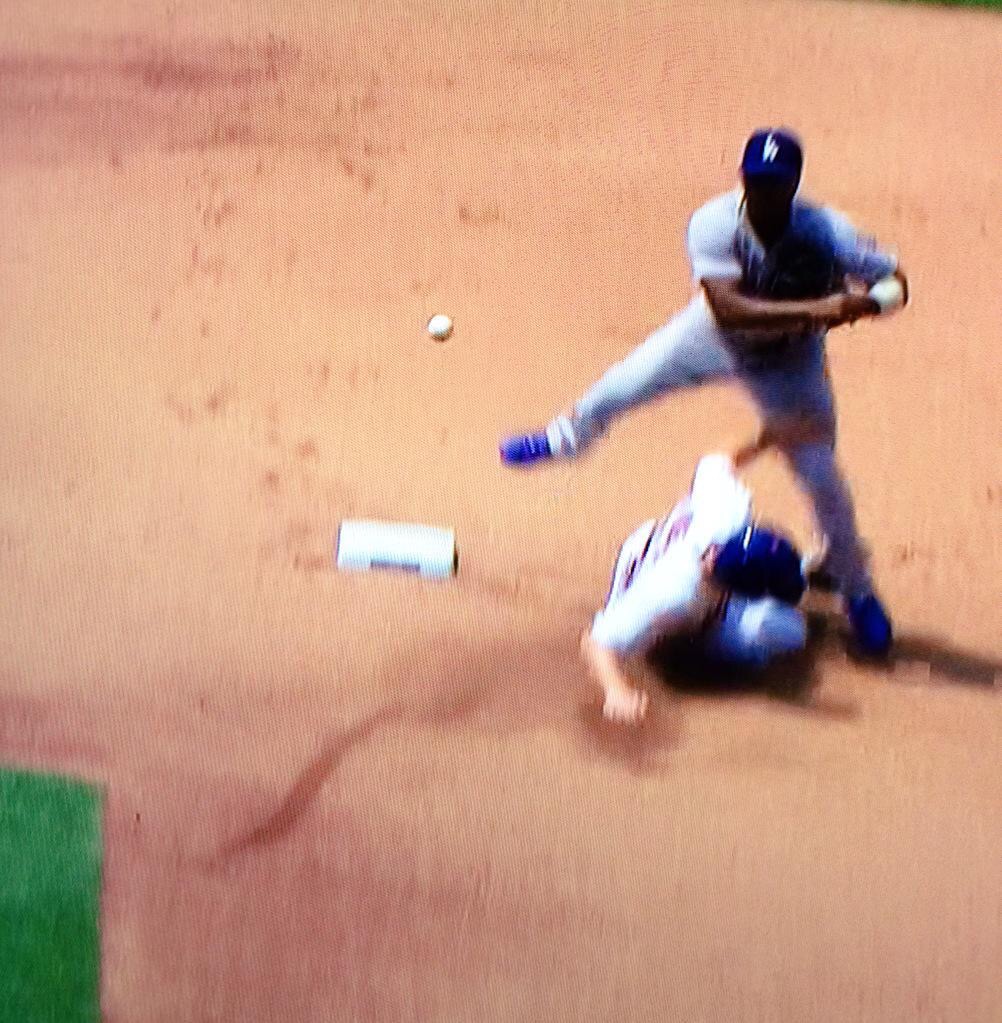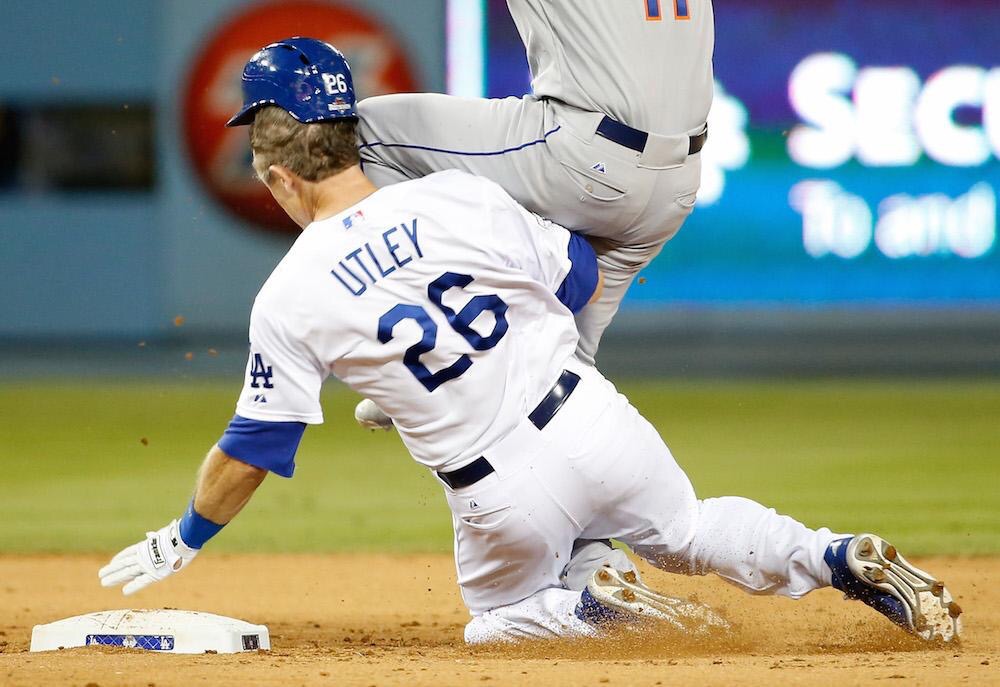It happened against twice last night. Jacob deGrom had what appeared to be a hustle double. Jonathan Villar appeared to have third stolen.
However, upon replay, both players were called out. Villar came off the bag during the slide. deGrom came off the bag when he popped up.
Btm 3rd – @Rockies challenge call that Jonathan Villar is safe at 3B; call overturned, runner is out. Powered by @Mitel. pic.twitter.com/dHhTxXIpIG
— MLB Replays (@MLBReplays) May 26, 2021
Btm 4th – @Rockies challenge call that Jacob deGrom is safe at 2B; call overturned, runner is out. Powered by @Mitel. pic.twitter.com/H8SplkNymv
— MLB Replays (@MLBReplays) May 26, 2021
Whenever, this happens there is consternation. Many voice they do not believe that is the purpose of replay. They’d rather it be for the “egregious” call and not the “technicality.”
Honestly, that position is more sour grapes than anything, and it’s a distortion of the real purpose of replay. The real purpose of replay is to get the calls right. The replay in both instances did its job by correcting a wrong call on the field.
Like it or not, both deGrom and Villar should’ve been ruled out. Replay did its job, and the Colorado Rockies were not victimized by a bad call.
Maybe.
The one unintended side effect we see with replays is a transition to how players are tagged on these plays. It used to be a quick snap tag to lead the umpire to believe you got him.
Now, fielders are taught to hold the tag. Essentially, they’re waiting for that split second (or more) the runner comes off the bag to get the out call. However, it’s a little more than that.
Look at that deGrom play again. Trevor Story appears to nudge deGrom, and you can see deGrom stumble a bit and come off the bag. That might’ve been what led to deGrom coming off the bag.
What’s interesting is there is no per se rule which prevents this. A fielder cannot inhibit a runner from running between bases. Catchers are limited in how they block the plate. However, there’s nothing that states a fielder can’t use a tag to push the runner off the base.
Therein lies the problem.
Between the replay rules and the lack of clarification on obstruction, fielders are not just incentivized to hold a tag on the runner. They’re also rewarded for nudging or downright pushing or knocking an otherwise safe runner from the base.
With the trouble scoring runs and producing offense, MLB should be addressing this very issue. It’s an easy fix too.
Since you can’t review “judgment calls,” there needs to be a clear-cut rule. For replays, it should be:
If a runner was called safe on the field, and upon replay it was determined the runner came off the base, the runner shall be deemed safe if a fielder kept contact with the runner for the duration of the separation from the base.
Put another way, fielders can no longer weaponize the tag. They can’t use it to make safe runners out. By doing that, you eliminate the portion of replay which causes derision amongst fans and teams.
By doing this, players who actually should be out are out. That is, unless, their ability to stay on the bag was interfered with by the fielder.
Going back to last night, deGrom would be called safe. Villar probably would be as well. That is, unless, they were initially called out on the field.
We can debate whether that’s preferable course of action. However, it does seem to be a much better course of action than letting runners be knocked off the base and penalized for it.
Time and again, people mistakenly assert Josh Smoker should be considered as a left-handed reliever out of the bullpen. The reason for this mistake is the obvious belief that just because Smoker is a left-handed pitcher, he will naturally give left-handed batters fits. Unfortunately with Smoker, that isn’t the case whatsoever.
During his brief stint in the majors last year, left-handed batters hit .366/.448/.600 off of him in 29 plate appearances. Unfortunately, this wasn’t entirely the result of a small sample size. In Triple-A last year, left-handed batters hit .282 off of him. In 2015, left-handed batters hit .250 off of him in Double-A. Simply put, Smoker is not your typical lefty out of the pen.
As a result, until Smoker finds another pitch to use to get left-handed batters out, he is going to need to be lifted when a left-handed batter comes to the plate. That is unless Smoker is able to learn how to utilize his slider against left-handed batters.
The slider is the obvious choice as: (1) Smoker knows how to throw a slider; and (2) Dan Warthen‘s specialty as a pitching coach is teaching the slider. If Smoker is actually able to master the slider, then he has a real weapon he can use against left-handed batters. The good news is he obviously has been working on the pitch, and he has had some success with it as Bryce Harper would attest:
At this point, Smoker either does not have the confidence in the pitch, or he does not throw the pitch consistently well. If he ever does get to that point, and he can combine the slider with his 96 MPH fastball, Smoker could very well be unhittable. Considering Smoker already dominates right-handed batters and struck out 14.7 batters per nine in the majors (12.8 in Triple A), you have a reliever who is a potential closer. You certainly have one that is more than capable of handling the sixth inning with Fernando Salas back in the fold.
Overall, should Smoker develop his slider, the Mets bullpen has the possibility of being one of the best in the major leagues. And with that, quite possibly, much of the success of the bullpen and the Mets 2017 seasons rests with Smoker mastering the slider. With Warthen as his pitching coach, you have to like the chances of that happening.
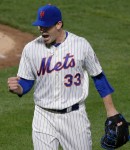
So far, the big Matt Harvey story of the preseason is the return of his vaunted slider. According to Harvey, he did not have it for most of last year.
For what it’s worth, Spring Training is always full of stories pumping up players. Every player appears to be in the best condition of their life. Players are healthier than they have ever been in their career. They’re either ready to build upon a strong season or put a tough season behind them. Does the supposed return of Harvey’s slider fit into that catergory?
In 2013, Harvey’s breakout season, he was 9-5 with a 2.27 ERA, 0.931 WHIP, 157 ERA+, 2.01 FIP, and a 9.6 K/9. He threw his slider 18.5% (504 total) of the time. Rather than try to explain how his slider moved, here’s a two graphs from Brooks Baseball showing the vertical and horizontal movement of Harvey’s 2013 slider:

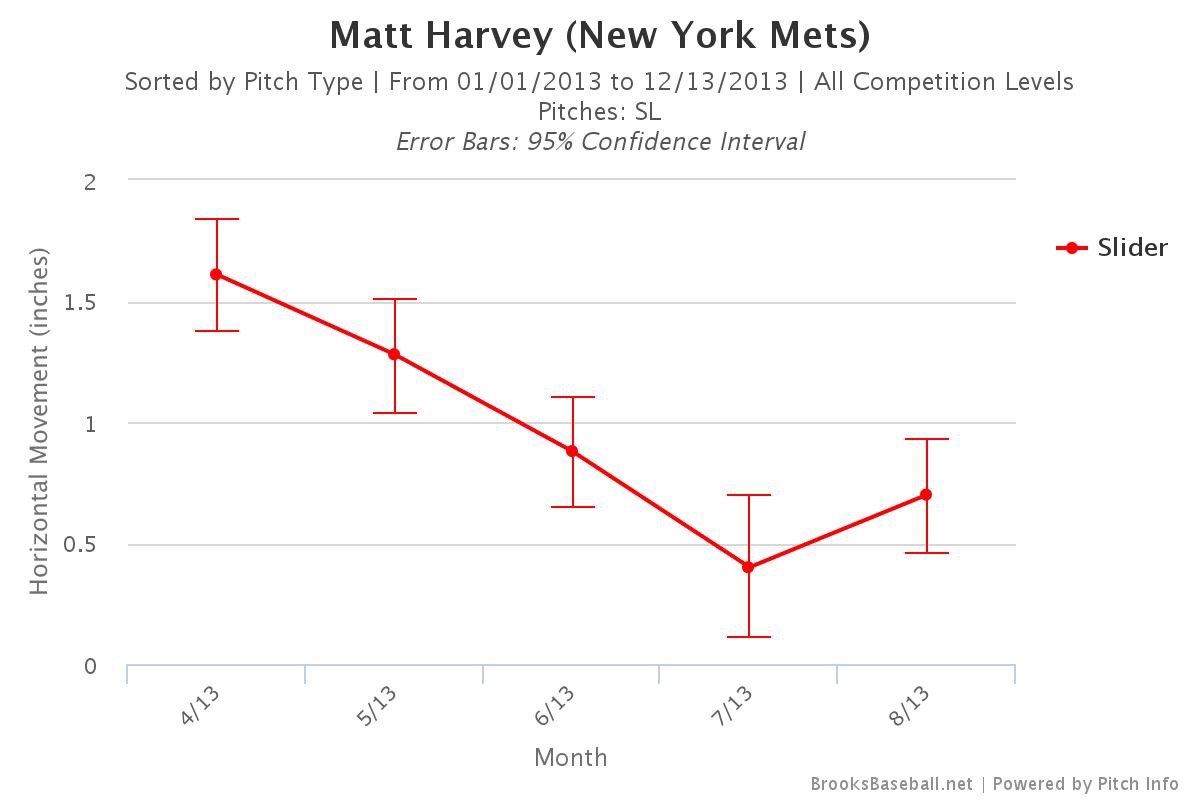 When Harvey threw his slider, it was swung at 49.01% of the time. When batters swung at the pitch, it was fouled off 15.8% of the time. It generated a swing and miss 17.66% of the time, and it was put into play 16.88% of the time. When contact was made, it typically generated a groundball. He only allowed two homeruns off of the pitch. In sum, it was a terrific pitch for him.
When Harvey threw his slider, it was swung at 49.01% of the time. When batters swung at the pitch, it was fouled off 15.8% of the time. It generated a swing and miss 17.66% of the time, and it was put into play 16.88% of the time. When contact was made, it typically generated a groundball. He only allowed two homeruns off of the pitch. In sum, it was a terrific pitch for him.
Now, if we use Harvey’s word that his slider didn’t return until the last quarter of the season, it means he didn’t have his slider until August. Again, using Brooks Baseball, here are graphs showing the vertical and horizontal movement of Harvey’s slider:


Taking a cursory look, Harvey’s slider had less horizontal and vertical movement. Unsurprisingly, the pitch was not as effective for Harvey.
From April to July, Harvey threw this slider less frequently than his old slider. His slider usage rate dropped from 18.5% to 15.12%. During these months, Harvey relied much more heavily on his fastball. Part of the reason for that might’ve been his lack of confidence with his slider.
When Harvey did throw his slider, it was swung at 43.92% of the time. When batters did swing at the pitch, they fouled it off 9.12% of the time, swung and missed 17.57% of the time, and put it in play 17.57% of the time. While the new slider did generate more groundballs, it did also generated less swings and misses.
More importantly, it needs to be reiterated that Harvey did not have the confidence in this pitch that he did in 2013. To an extent, it changed what he was as a pitcher, and the results showed. From April until July, Harvey went 9-7 with a 2.91 ERA, 1.06 WHIP, and an 8.5 K/9.
Harvey said he found his slider sometime in August. Here’s how his slider moved from August through the postseason:
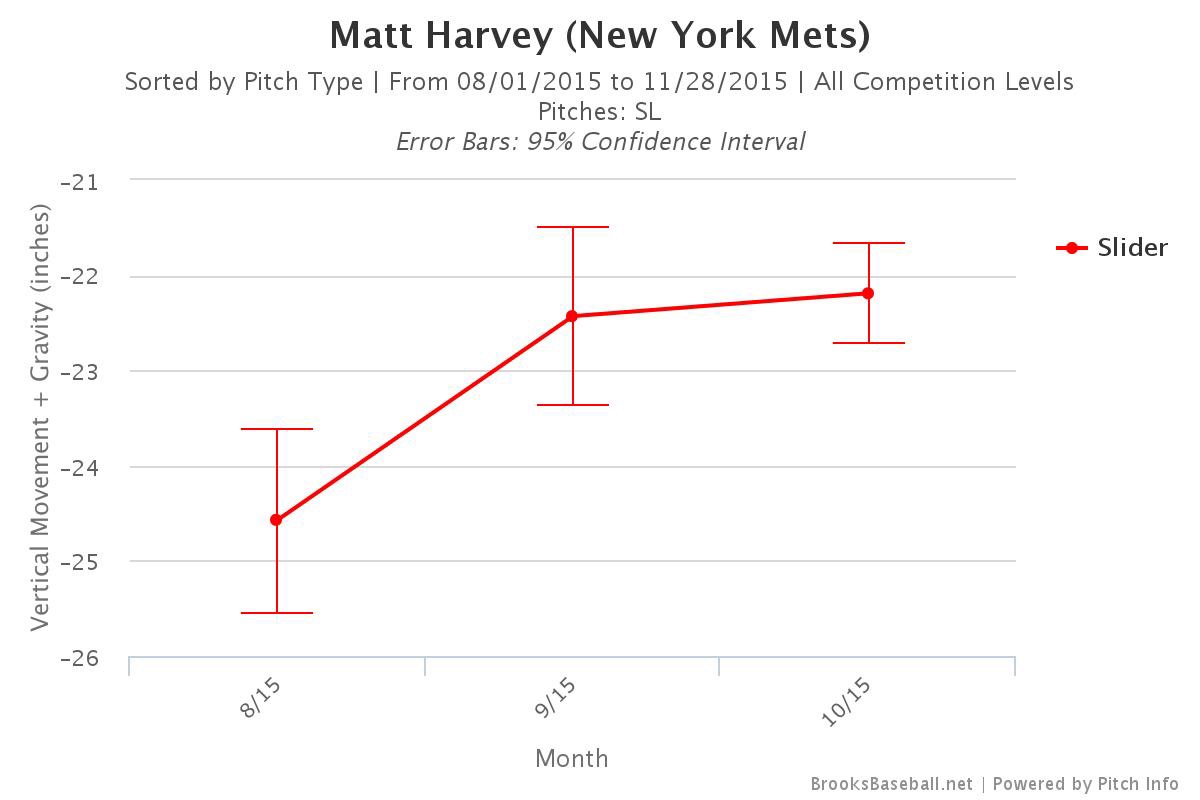
 Looking at the charts, Harvey’s slider appeared to get its movement back, especially in August. What is surprising is that Harvey used his slider even less frequently than he had done in the first five months of the season. His slider usage rate dropped to 13.10%.
Looking at the charts, Harvey’s slider appeared to get its movement back, especially in August. What is surprising is that Harvey used his slider even less frequently than he had done in the first five months of the season. His slider usage rate dropped to 13.10%.
When he did throw it, it was more effective. Batters swung at the slider 53.03% of the time. When batters did swing at the pitch, it was fouled off 15.91% of the time, swung and missed 18.94% of the time, and put in play 18.94% of the time. Harvey’s rediscovered slider was able to generate a similar percentage of groundballs as he had between April – July.
To close out the regular season, Harvey was 4-1 with a 2.24 ERA, 0.927 WHIP, and a 10.1 K/9. While we should always be careful of drawing conclusions from short sample sizes, it appears that the 2013 Cy Young caliber version of Harvey is back.
Judging from Harvey’s first Spring Training start, he still has his slider. With that, Harvey should have increased confidence, and more importantly better stuff out there in the mound. Now that the slider will be back for a full season, Harvey is back in the Cy Young discussion (if he ever left), and he is primed to dominate the National League.
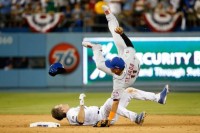
If you’ve been on Twitter, Instagram, or another social media site I’m not yet aware of because I’m getting old, chances are you’ve seen Daniel Murphy‘s takeout slide against Chase Utley:
Here’s the thing. If you want to tell me it’s a dirty play because Murphy can’t touch second, fine. However, you must concede two points: (1) Murphy slid; and (2) Utley could’ve avoided contact by sidestepping or jumping. With that in mind, let’s look at Utley’s slide again:
To avoid any confusion, here’s a still of the point of impact:
Is this the same slide as Murphy’s? Could Ruben Tejada protect himself? Of course not. Even if Tejada didn’t spin, with the way Utley slid/tackled Tejada, Utley’s arms are at Tejada’s hips. His face is buried in Tejada’s abdomen. This is not a baseball play. Stop kidding yourself.
Another point, people have picked the ONE questionable slide in Murphy’s career. Utley is a guy with a reputation for being dirty:
https://twitter.com/RosenbergMerc/status/653073357152251906
So tell me this, how are these two plays or players comparable? If you’re answer is anything other than they’re not, your a Dodger fan, hate the Mets, or both.
This will go down in the annals of trades I care about more than most, but Tyler Stuart was a high cost for Jesse Winker.
Now, to Mets fans Winker is Babe Ruth. This guy just wears out the New York Mets, and there is value in keeping him away from potential first round opponents. Still, a team building long and short term shouldn’t make a trade like this.
Winker is a platoon bat. Even if you want to say he isn’t, that’s likely his role on this team. He’s also on an expiring deal. Players like this are nice when they hit.
Remember back to Tyler Naquin. Mets fans were doing backflips over getting him. That was until he and his .203/.246/.390 batting line proved to be an abject disaster.
Notably, Jose Acuña has a 1.77 Double-A affiliate for the Cincinnati Reds. The 20 year old Hector Rodríguez has a .746 OPS in Single-A. We don’t know what they’ll become, but when Naquin gave the Mets nothing, these prospects were basically just thrown away.
Stuart, 24, had a pedestrian 3.76 for Double-A Binghamton. What you liked was the 2.1 BB/9 against the 9.6 K/9.
He’s predominantly a fastball-slider pitcher with a high swing and miss rate with his slider. Long term, he’s probably a reliever, and with his control, he could rotate between the rotation and bullpen. He’s probably poised to make his Major League Debut sometime in 2025.
To some extent, think José Buttó. Yes, the stuff is different and so is the control. However, Buttó flashed two good pitches in the minors. Now, he’s a solid pitcher in the Mets pen with a promise to become much more.
If we go back to 2022, you’d be tearing your hair out watching Buttó become a good reliever at a time where Carlos Mendoza has to sacrifice a chicken to get through a game where he needs to use more than one reliever, which is every game.
If we want, we can over focus on Winker not hitting in the postseason, but that was just four games. In the inverse, we can look at his good numbers against the Atlanta Braves this season.
The main thing to like about this deal is David Stearns is going for it. He’s not making the Josh Hader mistake with this team. So far, he hasn’t truly impacted the long-term outlook of the team.
That said, he paid a high price for a platoon bat. As we’ve seen time and again, unless you’re Steve Pearce on the 2018 Boston Red Sox, you typically come to regret these deals.
If Winker is Pearce, and the Mets win the World Series, who cares what Stuart does in his career. If the Mets don’t win, this trade was a mistake. Let’s hope this isn’t a mistake.
Good on the New York Mets players for making the decision hard for the front office. What once looked like a team that would be sellers is now a team who is in Wild Card position.
Certainly, the players don’t want to waste this opportunity. Francisco Lindor and Brandon Nimmo have already publicly put pressure on the front office to be buyers.
However, this is David Stearns at the helm, and he’s cut different. He looks to sustainable winners, not one-and-done teams. Remember, this is the same person who traded Josh Hader when the Milwaukee Brewers were in first place.
Looking at the Mets, they’re on the precipice of building that sustainable winner. They have starting pitching prospects less than three years away. They have position player talent closer than that.
The question for this organization is do they sacrifice the future for this year. Of course, it’s a balancing act. Certainly, the Mets can be on the alert for more Phil Maton type deals. However, the real difference making players come at a real cost.
There’s an argument for an alternative path. That path has been forged already by José Buttó.
For his part, Buttó had struggled in his early Major League starts. He was far better this year, and eventually, partially out of necessity, he was moved to the Major League bullpen.
As a reliever, he is 3-0 with one save and a 0.84 ERA. With him and Maton, the Mets have two reliable arms in front of Edwin Díaz. Obviously, a team with a 4.07 FIP, the tenth worst in the majors, needs more help.
If the Mets aren’t inclined to trade off top prospects to do that, maybe they should be using those top prospects in 2024.
Again, Buttó’s move there has paid dividends. There’s a chance Tylor Megill can help there. Looking at David Peterson, his experience out of the pen last year appears to be helping him as a starter this year.
It’s something we have seen work against the Mets in the past. No one needs to be reminded of Adam Wainwright striking out Carlos Beltran to end the 2006 NLCS.
Keep in mind, Wainwright was struggling in Triple-A with the Cardinals. He had a 4.64 Triple-A ERA. He proved to be a better Major Leaguer.
At the moment, the Mets have a trio of struggling starting pitching prospects in Triple-A: Dom Hamel, Blade Tidwell, and Mike Vasil. Looking forward, Hamel and Vasil will need to be added to the 40 man roster before the 2024 Rule 5 Draft this offseason.
Rather than trade these players (or others), why not give them a look in the bullpen. Let’s see Hamel’s high spin rates fool batters. Tidwell’s fastball/slider combination appears ready for a MLB bullpen now. Let’s get Vasil away from the ABS system.
Let’s see what these young arms can do now. We’ve seen teams do this all the time to help them win. For that matter, Stearns did that in Milwaukee with Corbin Burnes, Freddy Peralta, and Brandon Woodruff.
Stearns knows how to execute this plan. He knows how to take starting pitching prospects and move them to the bullpen with an eye towards eventually using them as Major League starters here.
The plan makes sense for the Mets in the short term. It could payoff in the long term. Perhaps, this is the way to improve the Mets bullpen now while working to develop their top prospects.
It had gotten to the point where it was no longer whispers. It was now fair to question if Max Scherzer was no longer a top of the rotation type starter.
Pick your reason. Pitch clock. With the ejection, maybe more scrutiny with his hands. Injures. Certainly, age.
Whatever the case, Scherzer wasn’t the pitcher this year he was in his career. He wasn’t even close to the pitcher he was until his last few starts of last year.
Through his first 10 starts, he was 5-2 with a 4.45 ERA, 1.235 WHIP, 2.2 BB/9, and a 9.5 K/9. His FIP was 4.36.
There have been some glimpses of the Scherzer of his prime. Mostly, he’s had some unexpectedly poor starts getting hit harder than he ever has been. His pitches are a hair slower.
All told, Scherzer has not been Scherzer. At least, he wasn’t that until his start against the reigning World Series Champion Houston Astros.
Scherzer was effective and economical. It’s a big reason why he was able to go eight innings throwing only 91 pitches.
Scherzer struck out eight and only allowed one earned on four hits and a walk. The Astros were completely dominated.
There are some caveats here. The Astros are in a stretch where they played 23 games over 24 days. Yordan Álvarez is on the IL.
Make all the excuses you want to make. None of those excuses made Scherzer fix his slider. That slider was nearly unhittable as evidenced by the Astros meager display.
More than anything, the Mets needed that. It’s been their vaunted rotation that has let them down this year. In many ways, Scherzer is the poster boy for that.
He could also be the poster boy for a Mets resurgence. If Scherzer is the pitcher he was against the Astros, the Mets are formidable again.
We can buy Scherzer turning his season around and being the pitcher he was against the Astros because he has been that pitcher in his career. That was the pitcher the Mets signed and built their World Series aspirations around.
The Mets needed Scherzer to be great against the Astros. He was. Now, they just need him to be Scherzer for the rest of the season.
The danger with calling up Mark Vientos was that Buck Showalter was not going to play him. That is just Showalter’s instincts when it comes to young players. While veterans need not have to produce to keep a roster spot, young players have to go above and beyond to earn playing time.
When Brett Baty was first called up, he was immediately put into a platoon at third base with Eduardo Escobar. What was bizarre about that was Baty was called up to the majors specifically because of Escobar’s struggles. Baty has since played his way out of the platoon.
For two years running, the Mets said when Francisco Álvarez was called up to the majors, he was going to be the primary catcher. However, when Álvarez was called up after the Omar Narváez injury, Showalter first made Álvarez the back-up to Tomás Nido.
Eventually, Nido’s struggles and eye issues forced him to the IL, and now Álvarez is the primary catcher. However, even with Álvarez being the Mets best hitter for over a month now, he still bats ninth.
That brings us back to Vientos.
Vientos was called up because Daniel Vogelbach was not hitting for power, and he was slumping. Tommy Pham was not getting it done either from the DH spot. Mostly, the Mets needed more power in their lineup. Given the power display Vientos was exhibiting in Triple-A coupled with him dramatically cutting down on the strikeouts, the Mets were almost forced to call him up.
When he was first called up, it looked genius. Vientos would homer off of Ryan Thompson to tie the game and spark what would be the Mets best win of the season. Notably, Vientos was just one of four players over the past three seasons to homer off of Thompson’s slider:
Good thing they didn’t call up Mark Vientos sooner.
— Mike Mayer (@mikemayer22) May 18, 2023
Even with the homer, the Mets would not get him back into the lineup. He sat against the right-handed Taj Bradley. However, he would get into the lineup again against the right-handed Cal Quantrill. In that game, Vientos came up with the big base hit off Emmanuel Clase in the 10th to pull the Mets within a run.
For Vientos, that was two games played with two big hits producing an RBI. Despite that, he would not appear in the lineup until two games later. Being fair here, one of the games he missed the first half of a doubleheader. Still, after two big hits, Showalter’s inclination was to sit Vientos for two straight games.
Vientos struggled against Shane Bieber, who was excellent over eight innings. Then again, the Mets lineup only produced two runs on seven hits for the day.
Vientos would start at DH in the first game of the series against the Chicago Cubs with Drew Smyly taking the mound. After going 0-for-2 with two strikeouts, Showalter pinch hit Vogelbach for Vientos when the right-handed Jeremiah Estrada relieved Smyly.
When Showalter pinch hit for Vientos, there were runners on first and second with one out. Vogelbach flied out with Francisco Lindor and Alonso moving up. You’ll note when Starling Marte, the Mets worst hitter this season, came to the plate, Showalter did not use Jeff McNeil to pinch hit for him. Instead, he left Marte in to ground out killing the Mets chances of getting back into that game.
With Marcus Stroman taking the hill, Vientos was again on the bench in favor of Vogelbach. Vogelbach was 0-for-3 with a strikeout. Again, Vogelbach had the type of performance which led to Vientos getting called up.
Taking all into account, here is where we are. Vientos was impactful the first two games but has not been since. He is struggling with sporadic playing time going 2-for-13 at the plate with a homer and two RBI (65 wRC+).
Vientos is not producing enough at the moment. He has also been taken out the rhythm he was in Triple-A with the sporadic playing time he has had. Put the blame where you want it, but the end result is Vientos not playing frequently and not producing the way he did even when he was first called-up.
In 2022, we saw a glimpse of what David Peterson could be as a starter for the New York Mets. Seeing that pitcher, the Mets cannot just give up on him as a starter. However, that does not mean they’re obligated to let him figure things out at the Major League level.
Through eight starts, Peterson is 1-6 with an 8.08 ERA, 1.744 WHIP, 3.2 BB/9, and a 10.4 K/9. The advanced statistics don’t provide much more promise either with Peterson having a 52 ERA+ and a 4.82 FIP.
At Baseball Savant, we see Peterson has a decent whiff rate and an excellent extension. However, that is just about all he is doing well with batters squaring him up easily and he’s getting little to no spin on his pitches.
His slider remains an effective weapon getting a 35.6 Whiff%. However, that is a steep drop-off from the 45.0% it was last year. With Peterson’s fastball being flat and hit hard, he can ill-afford the slider not being as elite as it was last season.
Part of the issue may be pitch mix with Peterson throwing fewer sliders and more change-ups and sinkers. The change has been effective pitch, so you understand the increased usage. However, for two years running, Peterson’s sinker gets mauled. At some point, he is just going to have to scrap that pitch because it is completely ineffective at the Major League level.
Between the pitch mix and whatever else is ailing Peterson, he has not been the pitcher he was last season. We see that being one of the driving forces in what has been a disappointing start to the Mets season.
Through his first eight starts (and two relief appearances) last season, Peterson was 4-1 with a 3.18 ERA, 1.346 WHIP, 4.4 BB/9, and a 8.3 K/9. Over that stretch, his FIP was 3.91. This is a completely different pitcher. He was one who gave the Mets a chance to win.
The Peterson we see this season is not giving the Mets much of a chance to win. With the Mets lineup devoid of power, they don’t have the chance to win games or even be competitive.
This leaves the Mets with few good options. Maybe, they need to give José Butto more of a look until Carlos Carrasco comes off the IL. At least, Butto has been more competitive. Again, it may not be the best option, but it is a better one at the moment.
Whatever the plan, the Mets are going to need the Peterson we saw in 2022 at some point this season. It is better to get him to Syracuse now to have him figure it out because right now it is just not working, and the Mets don’t have the bats to let him figure it out.
